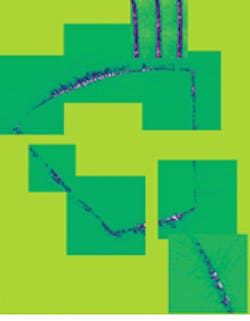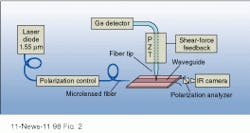WAVEGUIDES: Near-field imaging shows nature of propagation
A near-field scanning optical microscopy (NSOM) experiment has shown that light propagation through complex optical devices with subwavelength resolution can be completely assessed. The work was performed by researchers at France Telecom's Laboratoire de Bagneux (Bagneux, France) and the Laboratoire d'Optique Physique of the Ecole Supérieure de Physique et Chimie Industrielles de la Ville de Paris (Paris, France).
Several studies have investigated the capability of NSOM with subwavelength tips to map the propagation of light and the losses on top of guiding devices with a very high spatial resolution. Most of this work, however, has been done on dielectric waveguides. The French researchers were able to show that NSOM could measure optical intensity distribution with less than l/5 resolution on III-V optical devices operating at the important telecommunications wavelengths between 1.3 and 1.55 µm (see Fig. 1). Performance was also demonstrated on polymer and glass waveguides.
To obtain the measurements, the waveguide was illuminated by a 1.55-µm laser diode. Output was monitored by an infrared microscope, while—in the basic test—the top of an indium phosphide/indium gallium arsenide phosphide (InP/InGaAsP) waveguide was scanned by the tip of an uncoated, tapered single-mode optical fiber. A cooled germanium detector registered the results (see Fig. 2).Tien effect observed
The researchers discovered a side-benefit in this profiling of light propagation—they believe that the modulation pattern reveals an until-now unobserved small undulation of the light beam inside the waveguide, a phenomenon predicted by P. K. Tien in 1965.1,2 The Tien effect is caused by the balance between the converging effect of the index gradient in waveguides and the diverging effect of diffraction. The resulting phenomenon is of small longitudinal modulations of the center and radius of the light beam, especially pronounced in small guides.
This effect has been used by the researchers to enhance how the light path in complex devices was visualized and how the variation in light intensity along the path was monitored. The Tien effect was usually intentionally suppressed in the course of obtaining the mode profile and the variation of the average light intensity along the propagation path. But, because it appeared perpendicular to the propagation axis, the Tien effect proved useful in sections of devices where that axis was not clearly known, serving as a marker that visualizes the propagation.
Given that conventional far-field techniques no longer have the necessary spatial resolution, the ability to analyze optical semiconductor devices in this manner should prove increasingly important as devices continue to shrink in size and increase in integration.
REFERENCES
1. P. K. Tien, J. P. Gordon, and J. R. Whinnery, Proc. IEEE 53, 129 (1965).
2. P. K. Tien, Rev. Mod. Phys. 49, 361 (1977).
About the Author

Conard Holton
Conard Holton has 25 years of science and technology editing and writing experience. He was formerly a staff member and consultant for government agencies such as the New York State Energy Research and Development Authority and the International Atomic Energy Agency, and engineering companies such as Bechtel. He joined Laser Focus World in 1997 as senior editor, becoming editor in chief of WDM Solutions, which he founded in 1999. In 2003 he joined Vision Systems Design as editor in chief, while continuing as contributing editor at Laser Focus World. Conard became editor in chief of Laser Focus World in August 2011, a role in which he served through August 2018. He then served as Editor at Large for Laser Focus World and Co-Chair of the Lasers & Photonics Marketplace Seminar from August 2018 through January 2022. He received his B.A. from the University of Pennsylvania, with additional studies at the Colorado School of Mines and Medill School of Journalism at Northwestern University.

